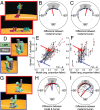Simulation as an engine of physical scene understanding
- PMID: 24145417
- PMCID: PMC3831455
- DOI: 10.1073/pnas.1306572110
Simulation as an engine of physical scene understanding
Abstract
In a glance, we can perceive whether a stack of dishes will topple, a branch will support a child's weight, a grocery bag is poorly packed and liable to tear or crush its contents, or a tool is firmly attached to a table or free to be lifted. Such rapid physical inferences are central to how people interact with the world and with each other, yet their computational underpinnings are poorly understood. We propose a model based on an "intuitive physics engine," a cognitive mechanism similar to computer engines that simulate rich physics in video games and graphics, but that uses approximate, probabilistic simulations to make robust and fast inferences in complex natural scenes where crucial information is unobserved. This single model fits data from five distinct psychophysical tasks, captures several illusions and biases, and explains core aspects of human mental models and common-sense reasoning that are instrumental to how humans understand their everyday world.
Conflict of interest statement
The authors declare no conflict of interest.
Figures




References
-
- Marr D. Vision. San Francisco: Freeman; 1982.
-
- Baillargeon R (2002) The acquisition of physical knowledge in infancy: A summary in eight lessons. Blackwell Handbook of Childhood Cognitive Development (Blackwell, Oxford), Vol 1, pp 46–83.
-
- Spelke ES, Breinlinger K, Macomber J, Jacobson K. Origins of knowledge. Psychol Rev. 1992;99(4):605–632. - PubMed
-
- Talmy L. Force dynamics in language and cognition. Cogn Sci. 1988;12(1):49–100.
-
- Tomasello M. The Cultural Origins of Human Cognition. Cambridge, MA: Harvard Univ Press; 1999.
Publication types
MeSH terms
Grants and funding
LinkOut - more resources
Full Text Sources
Other Literature Sources

